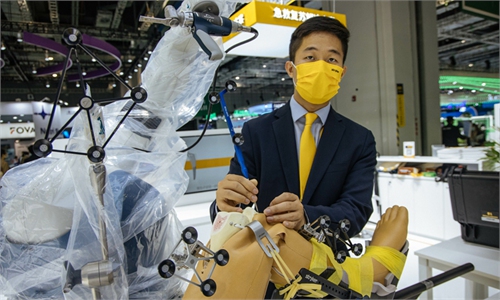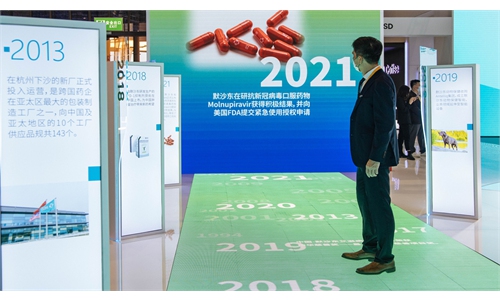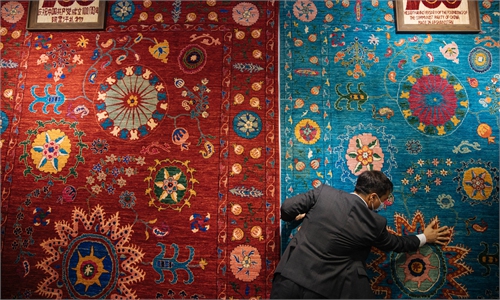Import expo offers ‘fast train’ on China’s devt for foreign firms, as nation’s carbon goals spur throngs of exhibitors
Firms eye historic opportunities in country’s green, innovation push
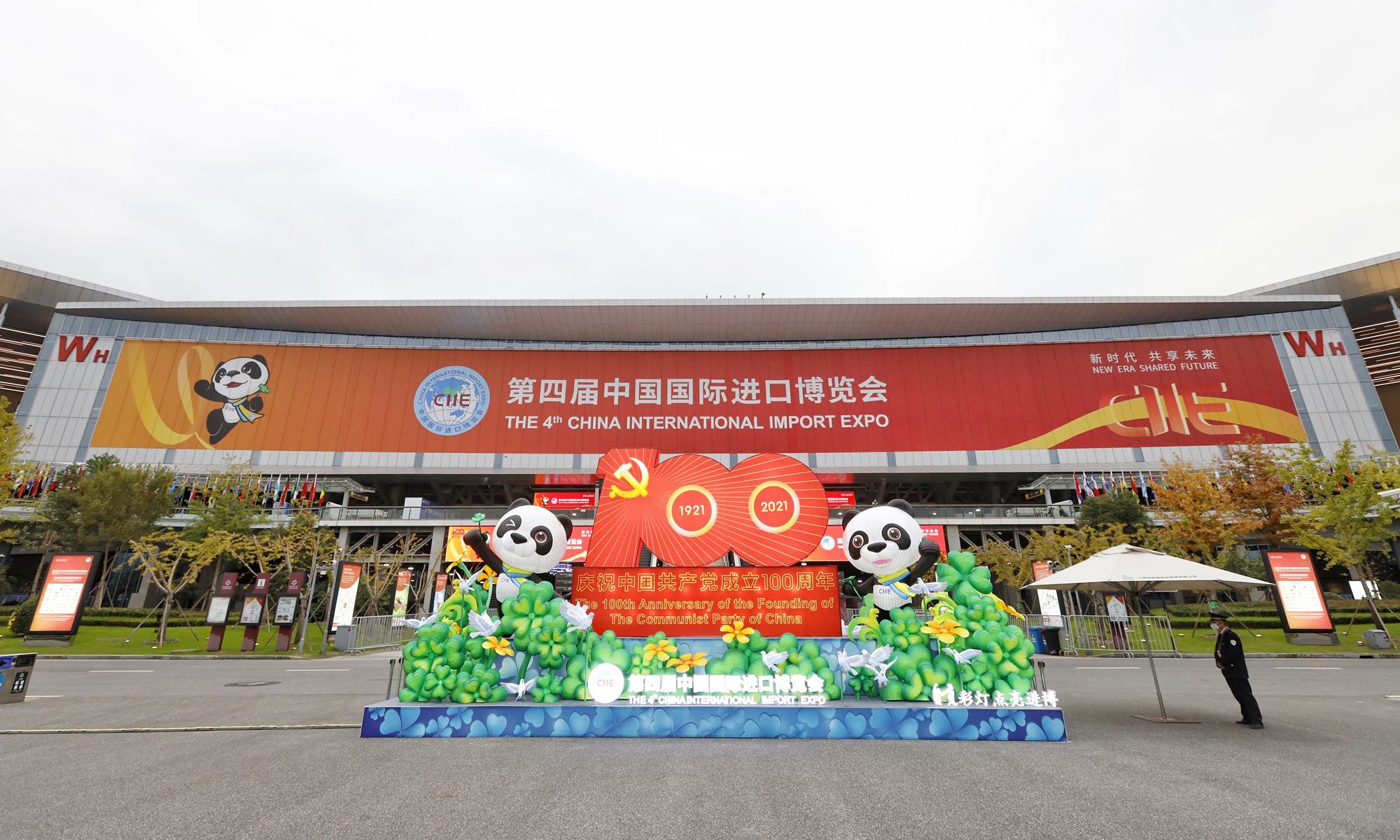
CIIE 2021. Photo: Li Hao/GT
The fourth China International Import Expo (CIIE), which kicked off on Thursday in Shanghai, is viewed as a bridge built by the Chinese government for countries and companies that want to take the "fast train" of China's opening-up and development.
With the presence of more than 1,200 buyers with an annual import value of over $100 million, and 39 trading groups and 599 subgroups for professional procurement, this year's expo offers a beacon of hope for a world economy severely battered by the lingering COVID-19 pandemic.
In many firms' eyes, the expo is no longer only about deals, but also a gala to which leading enterprises from all over the world bring their "coolest and latest" products amid the China's innovation and environmental push.
Held about one year after China announced its goals to achieve carbon emissions peak and carbon neutrality and weeks after several Chinese departments detailed their carbon-cutting goals, the fourth CIIE has become a stage for overseas firms, mostly from Europe and the US, to showcase their products and solutions or plant targets to better involve into the country's "lucrative initiative."
"For us, CIIE is a wonderful platform for learning and sharing new ideas… and we hope that through our participation in the CIIE, we can get a more comprehensive picture of the latest global consumer trends and find the areas where we can improve to better serve local consumers," Brian YIU, CEO of FILA China, told the Global Times.
As Global Times observed, the fourth CIIE could be summarized as "three more's" - more green, as almost all the exhibitors have showcased what they can do to coordinate with China's carbon targets, either with products, solutions or plans to reduce carbon emissions in their plants; more interesting, as CIIE has not only become a platform for making deals, but for showcasing foreign companies' concept ideas, business puzzles as well as culture; and more stringent, as the pandemic-prevention measures taken at this year's CIIE are even stricter than last year's event.
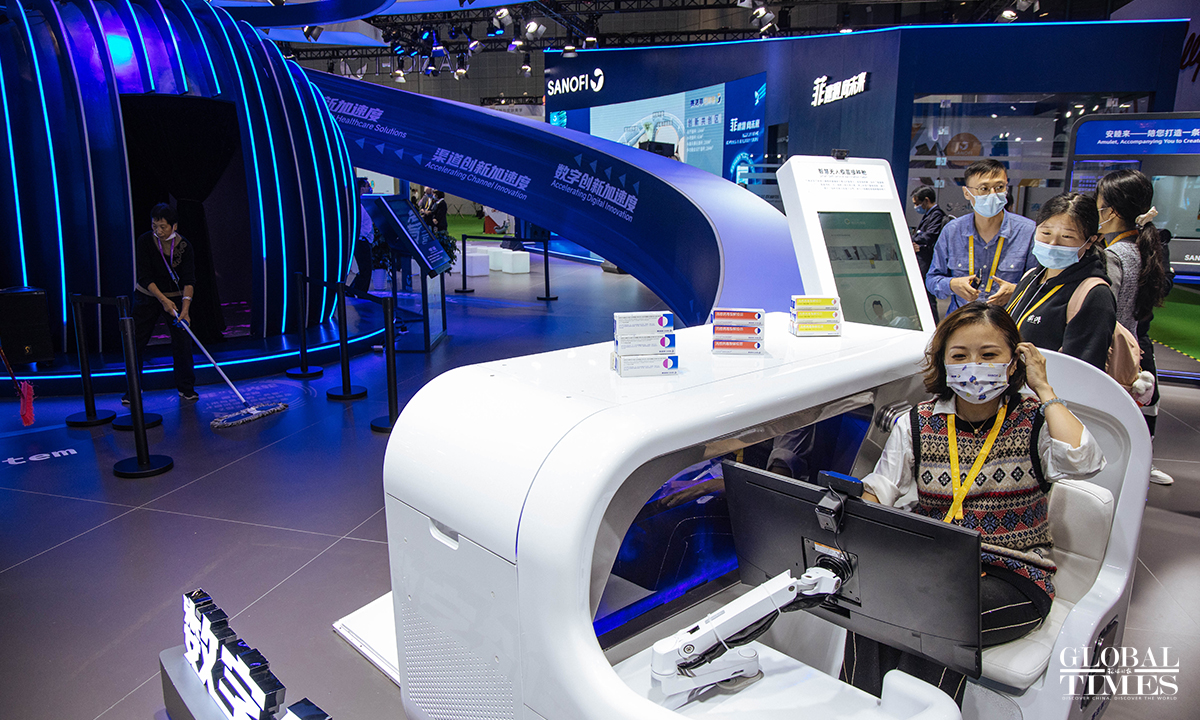
Photo: Li Hao/GT
More 'green'
A 10,000 square meter area called "low-carbon energy and environmental protection technology special exhibition zone" was set at one of the venues, the first time in CIIE history. This area has accumulated carbon-reducing solutions and products from around 50 global industrial firms - from zero-carbon architecture solutions, to protective materials that can extend the life of photovoltaic panels.
Many companies have put up boards that contain slogans of how they are going to achieve low-carbon targets in their Chinese plants, and some company representatives make "green supportive gestures," like watering plants with water pots, at their product launch activities.
On Friday, China released a new version of the investment catalogue for foreign firms, which offered a guide for foreign investors eager to take a slice of China's trillion-yuan carbon market expected to take off in the next few years.
"As the best and most feasible weapon for carbon neutrality, the power of digitalization is underestimated at present," Yin Zheng, Executive Vice President of Schneider Electric, told the Global Times, saying that the company hopes to grasp the opportunities unleashed by China's carbon goals for industrial pioneers with the firms' digital solutions and other related products.
Also, the Global Times observed that low-carbon has become a buzz word in the fourth CIIE, as many non-industrial firms also exhibited environmentally friendly products at their venues. The aforementioned FILA, for example, displayed a special silk material that has solvent recovery of nearly 100 percent.
"The 'double carbon' target set by the Chinese government has taken China's green economy to a whole new level," YIU said.
China's national carbon market, the largest emissions trading system in the world, made its debut in July with a turnover of 210 million yuan for carbon dioxide emissions on the first day, and could reach 284 billion yuan by 2025.
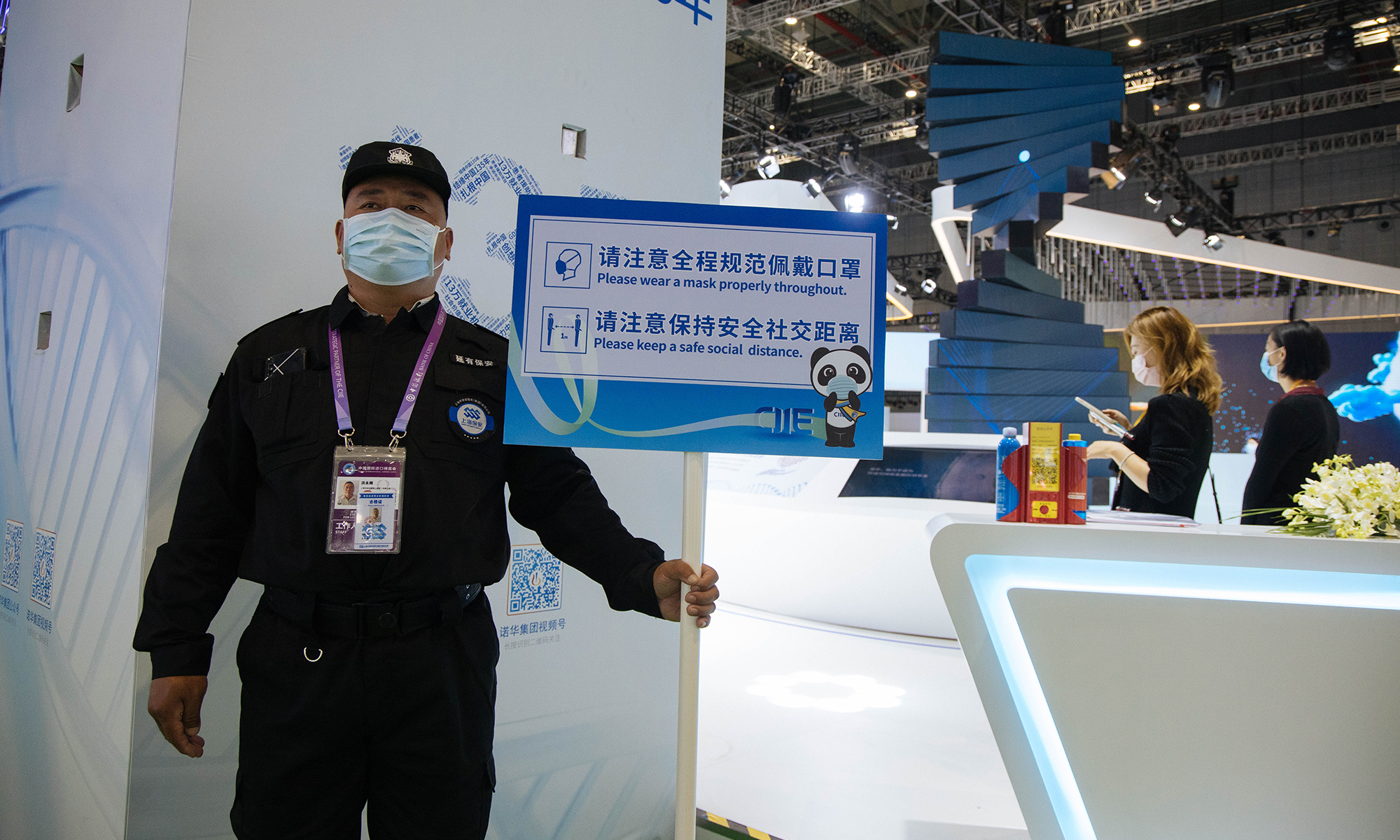
Photo: Li Hao/GT
More stringent
Amid a fresh wave of COVID-19 cases that has so far hit 20 Chinese provincial-level regions, epidemic-prevention measures taken at this year's CIIE are even stricter than last year, to reassure global participants.
For example, for any vehicles that enter the CIIE's exhibition hall area, security guard would take the temperature of each person, including passengers and drivers.
At many entrances of the CIIE halls, a white temperature-taking tent is set, and everyone who walks past the tent will be tested automatically. Besides, every attendant of the CIIE is required to provide negative nucleic acid test results acquired within 48 hours, which means that they have to take nucleic acid tests at least once every two days.
The stringent anti-epidemic measures also brought immense opportunities for firms. From air disinfection equipment, ECMO ambulance, to vaccine development solutions, many international healthcare companies brought their cutting-edge tech and products to the venue.
The 70,000-square-meter exhibition areas for medical equipment and healthcare products indeed attracted many visitors on the site. With the booming demands for epidemic prevention, the public's awareness for healthcare has also been enhanced.
Spanish company Flory Europa Banos attended this expo for the first time, and it introduced its air purification and disinfection equipment at the expo, with its virus removing rate reaching 99.96 percent and inactivation rate up to 99.6 percent, according to the company.
"We see a huge market potential in China as many venues including hospitals, campuses and public areas all need air purification due to the ongoing COVID-19 epidemic," Fan Sihua, chairman of the Spanish company, told the Global Times on Friday, noting that the Chinese market has accounted for around 80 percent the company's total.
The fourth CIIE has also become a gala for "first launches," whether in China or globally, as global companies look to match their best products with lurking potential demands from the huge Chinese market.
Edwards Lifesciences, a US-based medical appliance maker, displayed two "China debut" products - a blood monitoring surveillance platform as well as a surgical biological valve.
"The huge platform and powerful spillover effect of the CIIE have brought unlimited opportunities for companies like Edwards to share more about our advanced technologies for Chinese patients. This gives us confidence in further speeding up the review, approval and launch of our innovative products in China," George Ye, Vice President and General Manager of Edwards Greater China, told the Global Times.
Tesla has moved its Shanghai plant into the CIIE booth by displaying how a typical Model 3 is manufactured, from its motor system, batteries, to body shell and its chargers.
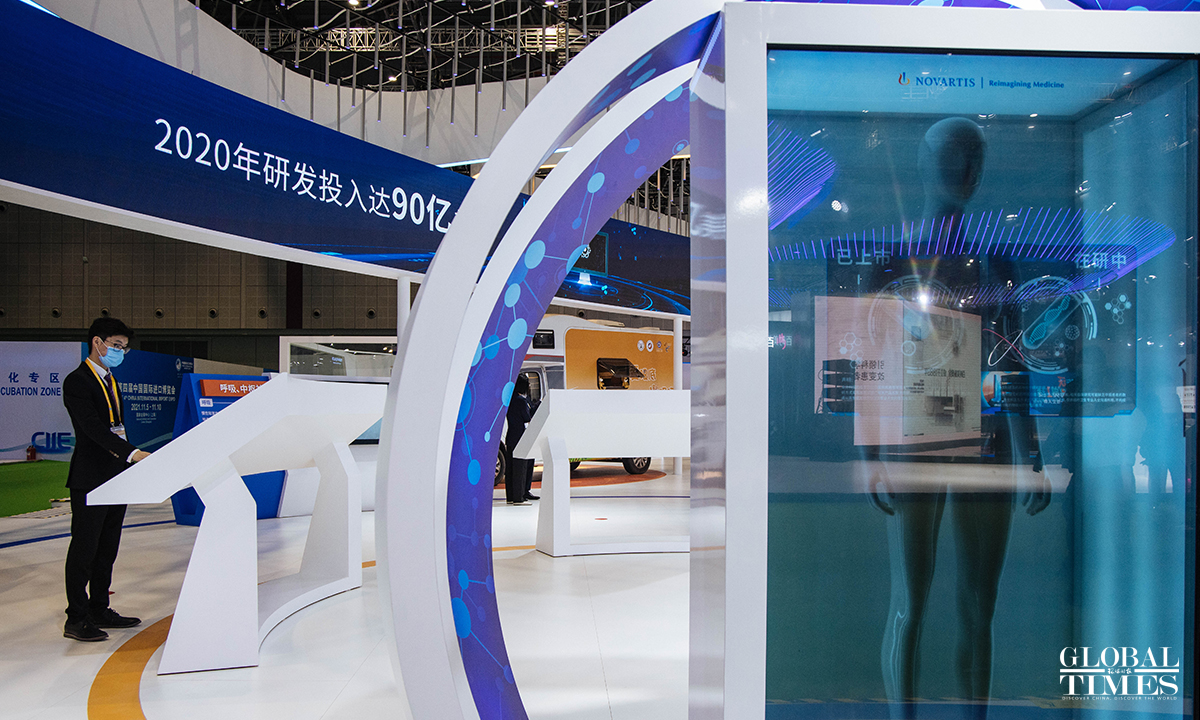
Photo: Li Hao/GT
A pie for all
The number of exhibitors to the expo increased to 3,000 from 2,700 in 2020, and they came from 127 countries and regions, a wider representation from last year's 120, despite that the coronavirus has greatly hindered global travel. Some expo exhibitors told the Global Times that the numbers could be bigger if it's not for the travel difficulties amid pandemic.
The US, seeing itself in a rising rivalry with China, but which has recorded a recent flurry of diplomatic activities, sent about 200 companies to the expo this year, reaching a new high.
The number of US companies participating in the first three CIIEs was 180, 192 and 198, respectively, always been at the forefront among its counterparts and maintaining a growth momentum despite that confrontation between the world's two largest economies was rising over the past four years.
According to a catalogue of exhibitors at the expo obtained by the Global Times, Japan fielded the largest number of companies with a total of 289 exhibitors. European exports powerhouse Germany fielded 167 exhibitors. Russia, which is enjoying its best historical ties with China, sent 42 companies.
Canada sent about 64 firms to the expo, which came just weeks after the safe return of Huawei's Meng Wanzhou. While Australia, which has been discriminating against Chinese investment, ousting Chinese companies, and meddling in China's internal affairs over the past days, sent more than 80 firms to the expo.
It's a further demonstration showing China's opening-up measures are non-discriminatory and for all, analysts said, urging countries that wanted to share China's development should treat Chinese firms the same way.
